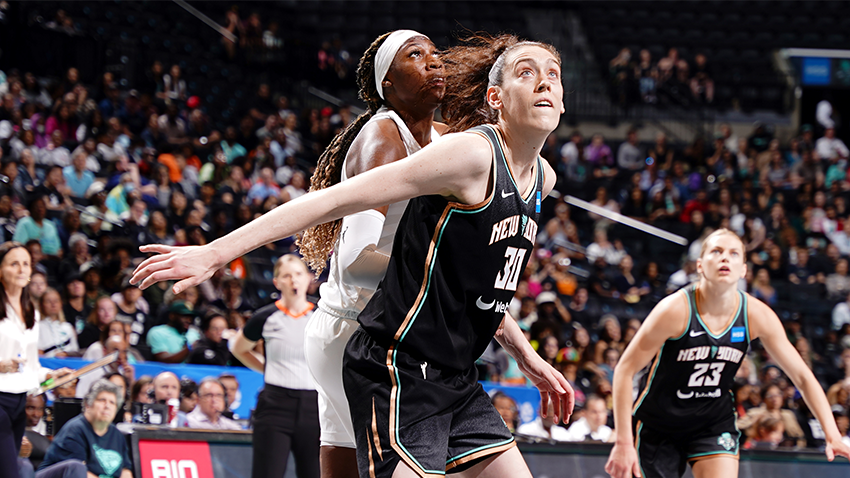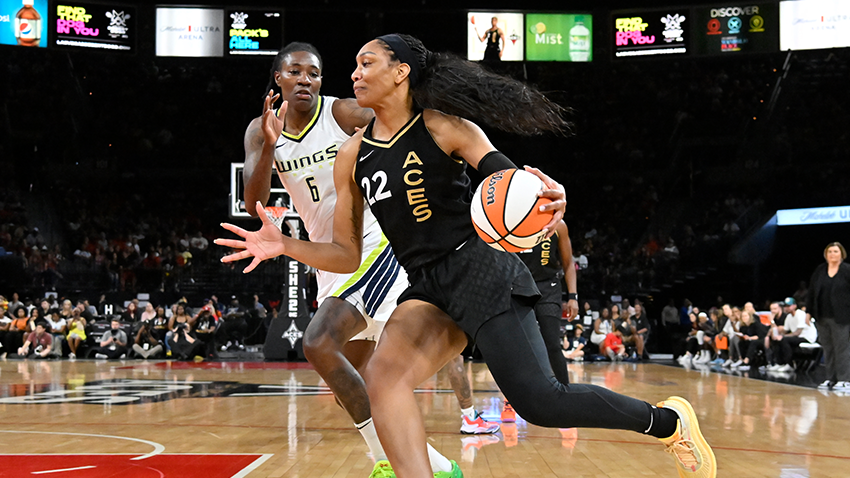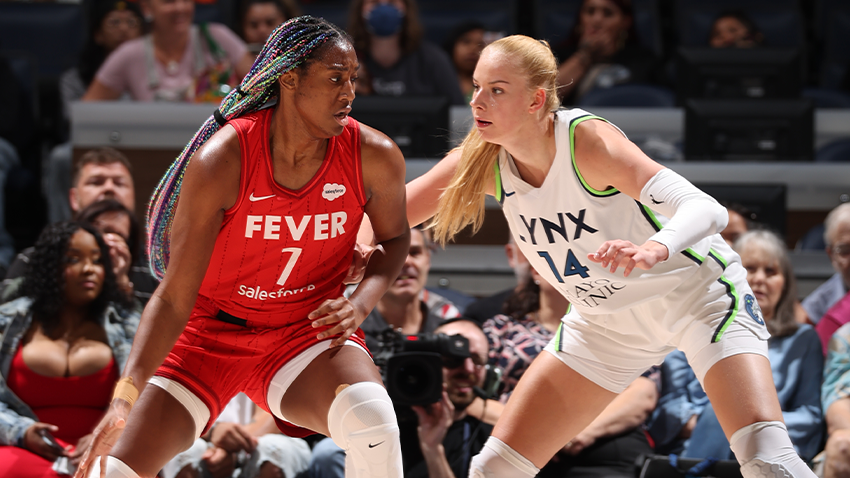Elite is Elite: The Art of Creation

As the W continues to transition more and more into modern basketball principles (space, pace, positional versatility), creation from the guard spot becomes increasingly paramount.
What is creation? It seems simple, but there are layers to what comprises it. Typically I break it down into a few aspects that overlap, and higher levels of creation are reached with consistency and efficacy in those aspects.
- What is your burst, acceleration, and first step like? Can you create separation with footwork?
- Can you manipulate a defender/defense with your handle?
- How quickly do you recognize and attack gaps/openings?
- Can you create space in multiple directions? RE: side-steps, pull-ups, step-backs, and wide dribbles?
- Do you have the scoring ability and variation to make the defense care?
That’s a lot to throw out, but think of it like this: the very best creators are the players who consistently create good looks for themselves or their teammates through a blend of all those aspects.
Looking at the first step, Kelsey Plum is blinding off the dribble. Especially in Las Vegas’ five-out offense that stretches defenses to the brink, Plum is incredibly effective off the catch and initiating the offense herself.
Plum’s speed and burst are apparent when the Aces work to get her onto a mismatch, and she knifes into the paint.
Few frontcourt players have a prayer at holding up on an island against Plum. And while her lightning-quick first step is essential, how she plays out of, it makes it matter that much more.
She’s elite with her skip step, bounding up the court and setting defenders on edge with an erratic tempo.
She freezes defenders for just a hair of a second by rocking back and forth on the transmission and then hitting 0-100 faster than anyone can keep up with.
When she doesn’t have a clear look at the rim, she blends in her footwork and ability to operate at slower speeds and decelerate to punish defenders she got on her back hip with her initial attack.
Arike Ogunbowale is the other first-step savant that comes to mind, and her pension to attack defenses with pace in transition and then draw help is mesmerizing. More importantly, it’s been incredibly effective for her and the Wings’ offense this season as she continues to improve as a playmaker.
Watch how Marine Johannès reacts to Arike’s initial probe; the defense is here to sell out for that drive. Arike reads that, draws Johannès back in the other direction, calls for the screen from Kalani Brown, and then attacks off the cross back in the other direction.
Brown slips the screen, but Arike already has the head of steam. Nyara Sabally retreats to guard the roll, Breanna Stewart peels off the strongside to put two to the ball, and Arike finds the cutting Odyssey Sims.
Arike doesn’t even touch the paint, but her first step and burst set up the entire play, creating an efficient look that impacts the defense.
Indiana’s Kelsey Mitchell features that first step with a powerful, tight, side-to-side rhythmic handle. She sets up her screens with her dribble, but the threat of her shot and drive leads to her ability to toy with coverages from the mid-range.
Watch how Mitchell sets her defender into the screen twice. First, dragging the play out into the deeper waters of the slot and then jolting back, timed perfectly with the screener setting. She then threatens with a pound dribble and jab to her left as the screener flips, and her defender takes a step in along with her, getting caught by the screen again.
In an emptied-out corner with no immediate help for the big in the screening action, Kelsey has the space to attack as she pleases, this time opting for the in and out to freeze the big, feigning another drive and forcing the big to stay a step off, and collecting into a side-step pull-up jumper.
The result is a swished open jumper, but the process to get there stands out.
Leading the league in scoring and doing so with impressive efficiency considering how absurd her usage is carrying the Storm, Jewell Loyd creates space out of thin air. According to Basketball Reference, Loyd has a 34% usage rate this season. To put that into perspective, her career usage rate is 26.1%, and no player who has played 100 minutes or more this season has eclipsed a 30% usage rate.
The Storm are building into a new era, and Loyd has seen tighter defenses more consistently than she has at any point in her pro career. Every night, all eyes of defense are on Loyd. Game plans are built to stop her or at least slow her down, and watching her still thrive has been incredible.
Jewell sets a screen herself at first, something she does often in Seattle’s offense, creating initial movement and potentially snagging her some air space. Then she slows into a screen, doesn’t love the driving angle on a potential rejection, and rips through and around the screen.
Brittney Griner plays up to the level of the screen and retreats once the screen happens, recovering to Mercedes Russell on the roll. Loyd uses this slight gap and exploits it, as Moriah Jefferson has been momentarily screened out.
Rather than hitting the gas right off the screen and running into Griner, Loyd pauses, looks at Russell on the roll, and THEN hits the gas. Griner recovers to Russell, Jefferson is now back on her hip, and Griner takes a prodding step, but it’s too late as Jewell takes a chopping step to balance herself and pop off a floater.
Creating space in a vacuum sets Jewell Loyd apart.
Rhyne Howard has already cemented herself as one of the best in a similar vein of lateral creation and attacking off of screens to get to spots with movement. So often, a good handle is thought of with respect to how someone can get into the paint. While there’s truth to that, I see it more as getting to where you want to with ease, something Howard exemplifies in a non-traditional way, although she’s rapidly improving at getting into the paint.
Watch how Howard reads that she has A’ja Wilson switched on her after coming off the screen. Wilson is the reigning DPOY and one of the most mobile frontcourt players in the sport. It’s not a ‘mismatch’ per se, but Howard knows, “I can get to my spot,” and that she can fluidly and consistently get to this shot is remarkable.
It looks minute in watching, but think about it: Howard goes from the nail to the slot and into her shooting rhythm in two steps and half a second. She goes from half a foot of space to nearly six feet of it when she’s in her release. There are a handful of players who can create space like that and hit those shots at a high enough clip to make the defense regret mistakes.
With an All-Defensive Team member Brittney Sykes guarding her, Howard drifts to replace the space Aari McDonald just vacated and opens up an angle for McDonald to pass the ball. Sykes recovers after losing Howard for a split second and flies into the air to contest the jumper… but Howard isn’t taking the jumper.
She’s stepping to the side off an up-fake and gathering into a wide-open pull-up three-pointer—lateral creation at its finest.
There is no one, in my opinion, that epitomizes and defines creation at the highest level more than Chelsea Gray.
Lest we forget what she did in the 2022 playoffs, leading the Aces to their first franchise title and the first title in Las Vegas pro sports with one of the most incredible postseason runs in basketball history.
Gray creates in a way few can replicate. Her game is defined by counters and quickness in cycling through them. She sees the court in a way perhaps no one else can in the league and picks it apart with her handle, shot-making, and an unreal array of head, body, and ball fakes. Gray is ‘death by a thousand cuts’ on the basketball court, creating in ways few can replicate.
Attacking an emptied-out corner in isolation, Gray hits a nasty outside in and out, then a behind the back to the right, then between the legs to go back left, then a few cagey probes to the left while holding Kelsey Mitchell off with her right before fading left into her silky j.
Gray doesn’t technically “separate” from Mitchell until the last moment, but that’s part of what’s so astounding about watching Gray operate. Mitchell stays in front but is not on balance for most of the possession. Gray eviscerates angles with her manipulation as a ball-handler and quickness in attacking them.
She will find a way to exploit whatever coverage you throw at her.
As guard play and perimeter creation becomes increasingly essential, the best creators in the league and those coming into it in the next half-decade are making their marks at the right time.
WNBA reporter Mark Schindler writes a column on WNBA.com throughout the season and can be reached on Twitter at @MG_Schindler. The views on this page do not necessarily reflect the views of the WNBA or its clubs.











,xPosition=.5,yPosition=.5)
,xPosition=.5,yPosition=.5)
,xPosition=.5,yPosition=.5)
,xPosition=.5,yPosition=.5)